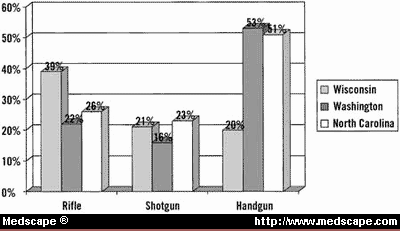 The deaths of children and adolescents killed in firearms-related violence in cities is no greater than the deaths of those who die in rural settings. In fact, suicides and shootings are actually more common among country dwellers than among city dwellers. Such was the surprising conclusion of a recent-released eight-year study of 24,000 firearms deaths in both environments. Past studies have shown similar disparities in the causes of firearms deaths, but this is the first to show that disparities exist in the pediatrics population too. Results of the study first appeared in the June issue of Pediatrics, the official journal of the America Academy of Pediatrics. The findings reflect the fact that the greater homicide rate in urban areas “is counterbalanced by greater suicide and unintentional firearms death rates in rural counties.” The lead author, Dr. Michael Nance, of Children’s Hospital in Philadelphia, has asserted that the findings “debunked the myth that firearms death is [only] a big-city problem”.
The deaths of children and adolescents killed in firearms-related violence in cities is no greater than the deaths of those who die in rural settings. In fact, suicides and shootings are actually more common among country dwellers than among city dwellers. Such was the surprising conclusion of a recent-released eight-year study of 24,000 firearms deaths in both environments. Past studies have shown similar disparities in the causes of firearms deaths, but this is the first to show that disparities exist in the pediatrics population too. Results of the study first appeared in the June issue of Pediatrics, the official journal of the America Academy of Pediatrics. The findings reflect the fact that the greater homicide rate in urban areas “is counterbalanced by greater suicide and unintentional firearms death rates in rural counties.” The lead author, Dr. Michael Nance, of Children’s Hospital in Philadelphia, has asserted that the findings “debunked the myth that firearms death is [only] a big-city problem”.
The study notes, though, that cities do have higher rates of firearm homicides, whereas rural counties experienced higher rates of suicide and unintentional firearms deaths. Prevention strategies, it concluded, should be tailored to the needs of these two geographic regions in an effort to reduce death rates. In a severe disappointment for gun-control advocates, however, the Supreme Court’s recent ruling allowing handguns in the home for self-defense represents a sharp set-back. Gun control advocates now expect a spike in firearms-related deaths nationwide. Nevertheless, a step in the right direction remains the closing of gun show loopholes that allow firearms purchases without background checks.
George Anderson, S.J.








Many have considered long guns to be less a problem because they can't be concealed. No so in Wisconsin, where I suspect many long guns are not locked up, or if one is hunting with Dick Cheney.
The medical profession could develop a standard questionnaire that could tease out further variables and info-every fire arm wound (I believe) is reportable.
bvo